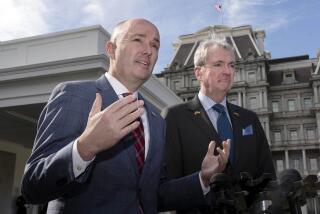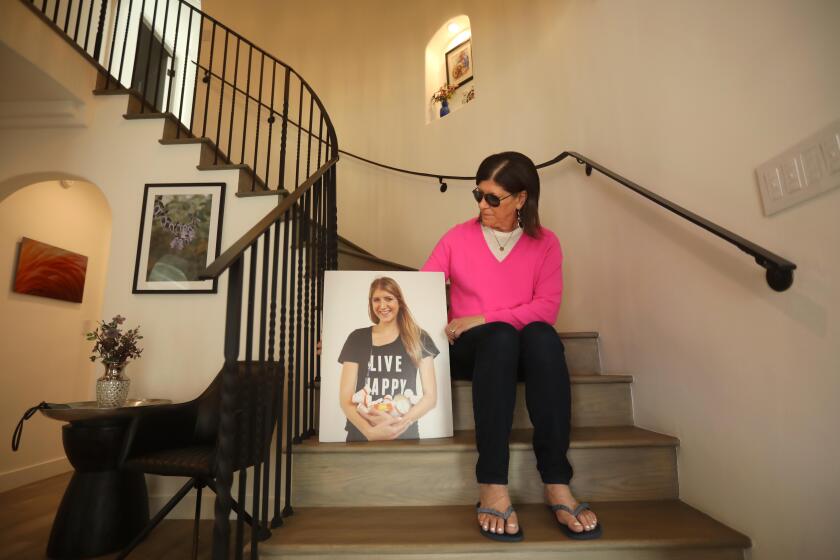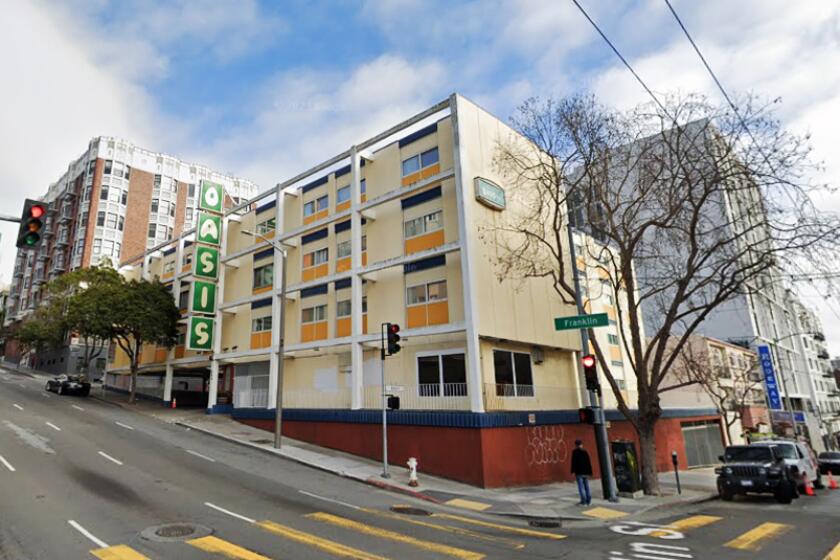Cameras Give Park the Once-Over
It’s a sunny afternoon at MacArthur Park, and for the regulars, it’s business as usual.
Amid the baby strollers and pickup soccer games, people quietly offer passersby fake passports, driver’s licenses and Social Security cards. Drug dealers hawk their wares.
For decades, the park has been plagued with crime, so much so that the Los Angeles Police Department targeted it in 2002 as one of three areas of particular concern that needed heavy patrolling.
Now, officers have new allies: seven surveillance cameras.
Over the five hours a day that the cameras are monitored, the focus is on locating drug dealers, buyers and users. One officer called it “virtual patrolling.”
Three to five days a week, Officer Christine Labriola scans the 40-acre park via remote control, looking for hand-to-hand transactions, people whose seemingly casual contact is too long and drug users trying to take a quick hit. The cameras can be zoomed, tilted and panned. When Labriola, a narcotics expert, sees what she thinks may be illegal drug activity, she radios, and bike and foot patrol units move in.
Since the cameras were first used in surveillance operations in mid-January, there have been 51 arrests, Officer Mark Hubert said. Nearly all of those were narcotics related.
Crime statistics are encouraging. From January through March of last year, there were 26 shootings, 234 robberies and 600 major assault crimes in the park. For the same period this year, shootings had dropped to 13, robberies to 202 and major assaults to 544. Officials credit the drop to the more intense patrolling in the park, as well as the cameras.
“This is the wave of the future. It’s the only way we’ll be able to maximize our resources,” said Capt. Charlie Beck, commanding officer of Rampart Division.
Police offered details of just five of the arrests that have been made so far, all for narcotics-related crimes. Three cases are pending in court. One was dismissed by a judge for lack of evidence, and for the remaining one, prosecutors declined to file criminal charges.
One person who is awaiting trial for alleged possession of narcotics is Michael Noel, 50, who was arrested Feb. 5. Labriola said video monitors caught Noel, who allegedly lifted his shirt over his face while he smoked from a pipe. She called in officers, who found crack cocaine on Noel, according to the police report.
“I can tell that this is about to happen and 30 seconds later, I can notify officers,” Labriola said.
The one man who beat charges jumped in the lake in the park and allegedly disposed of the drugs. Two police officers used a paddleboat to try to find the reputed contraband but failed.
Narcotics arrests can’t be made solely on the basis of videotape evidence.
“No matter how much you see on tape, you have to recover the drugs to make an arrest,” Beck said.
Cameras are not new to the LAPD. In 2001, motion-sensing cameras designed to deter graffiti vandals were installed in Hollywood and the San Fernando Valley. When a camera is activated, a recorded announcement is played, warning that photographs will be taken. Four cameras funded by local businesses and monitored by private security firms are operating in Trinity park south of downtown, and 12 more are stationed along Central Avenue.
The International Assn. of Chiefs of Police estimates that 38% of U.S. police departments use cameras, mostly for graffiti and traffic. But only a handful nationwide, according to Grady Baker, project manager with the research division of the IACP, use them as a type of virtual patrol.
The main deterrent is cost, Baker said. Costs for the MacArthur Park project, not including maintenance, were at least $50,000, according to market prices for similar cameras and equipment. General Electric Co. donated the cameras, and Hamilton Pacific donated software and installation services.
Late last year, the New Orleans Police Department installed dozens of cameras throughout the city and has plans to install hundreds more.
In Chicago, 30 cameras have been put up since last summer, placed in areas where “we’ve had experience with high drug trafficking to disrupt activity,” a spokesman said.
The Washington Metropolitan Police Department uses its cameras primarily during high-security events including World Bank meetings and the State of the Union address, though it also monitored antiwar rallies in 2003. During one operation, a 40-member team including police and FBI agents monitored the 14 cameras, which are placed in high traffic areas, including Union Station and the Capitol, said Neil Trugman, law enforcement and intelligence coordinator for the Washington police.
The use of cameras there has drawn vocal opposition and congressional hearings. The Washington-based Electronic Privacy Information Center has urged the creation of strict guidelines. How long recordings would be retained and with whom the information could be shared is of special concern, said Cedrick Laurant, the group’s policy counsel.
In sheer numbers, no American police department comes close to the use of cameras in Britain. London alone has an estimated 150,000 cameras, and the average person’s image is captured 300 times a day.
Clive Norris, a professor at the University of Sheffield in England, has studied the effect of cameras since 1993. “The gaze of the cameras does not fall equally on all users of the street but on those who are stereotypical predefined as potentially deviant,” he co-wrote in “The Unforgiving Eye: CCTV Surveillance in Public Space.” The report also found that blacks were “between 1 1/2 and 2 1/2 times more likely to be surveilled” than other groups.
In MacArthur Park, no one interviewed on a recent visit realized they were being watched. Reactions were mixed.
Shortly before sundown, Rufina Salas circled the park with her two kids. She was pleased to hear of the cameras. “The kids are little, and it’s no good for them to be around” bad behavior, she said. They will be able to enjoy the park, she said, and “not have to see bad things.”
Steve Williams, 21, said the cameras might take crime “out of the park but that doesn’t stop it.”
Mike Ghassemi, manager of More 4 Less, a general market that borders the park, is a fan. Ghassemi, 26, who has worked at the store for nine years, said the cameras could help officers “detect patterns. They could help them catch drug dealers and see who’s doing what.”
The slight time delay in transmitting images from the park to the stationhouse has prevented officers from monitoring the cameras out of the Rampart Division station, a little over a mile away. Labriola works out of a location near the park.
Officers hope to change that, as well as arrange for the installation of stronger lights that would allow use of cameras at night.
More to Read
Start your day right
Sign up for Essential California for news, features and recommendations from the L.A. Times and beyond in your inbox six days a week.
You may occasionally receive promotional content from the Los Angeles Times.






